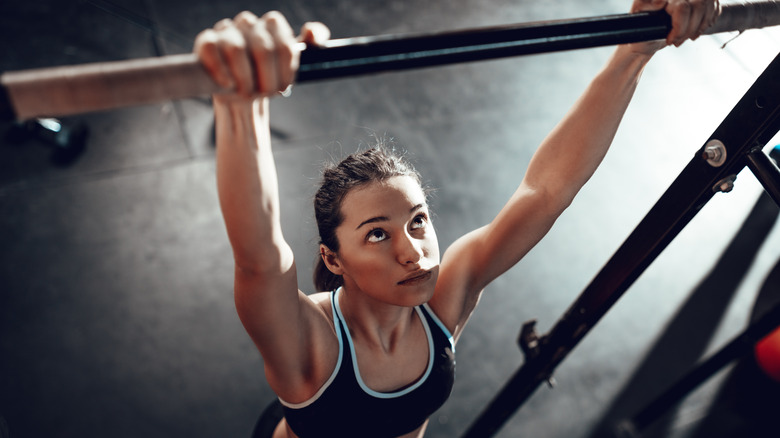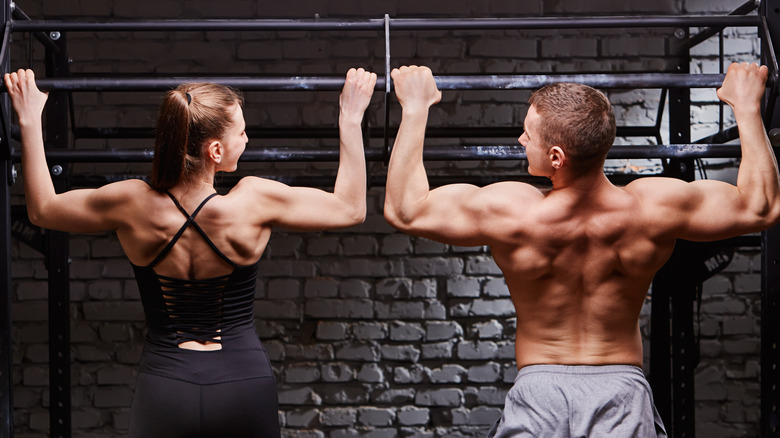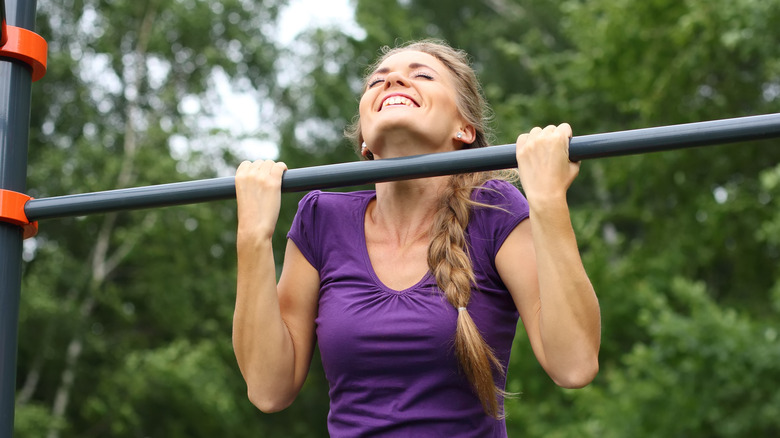Are Chin-Ups Or Pull-Ups A Better Back Exercise?
A strong back might look good in a tight T-shirt, but it can also help with mobility, balance, and supporting the spine (via Livestrong). If you sit at a desk all day, your back muscles easily get weak, which makes you more prone to stiffness and limits your movement. To keep the back muscles strong, there's no better move than pulling exercises such as the pull-up or chin-up.
Although both exercises require pulling your body against gravity to reach the bar, they are somewhat different in technique. According to a 2010 article in the Journal of Strength and Conditioning Research, the overhand, wider grip of the pull-up puts more force on the lower trapezius, whereas the underhand, shoulder-width grip of the chin-up recruits the biceps and pecs to do some work. However, a 2017 article in the Journal of Electromyography and Kinesiology found that most of the same muscles were targeted in both exercises.
Pull-ups and chin-ups are both great for building upper body strength, but which one is a better exercise for your back?
The pros and cons of the pull-up
According to Healthline, the pull-up is considered to be the classic exercise in bodyweight workouts. Building back strength in a pull-up requires a strict form using no momentum in the lift, according to Men's Journal. The pull-up doesn't rely on your biceps to help you through the movement. Therefore, pull-ups force the other muscles of your back to fire you up to the bar (via Barbend).
This also means that pull-ups are very difficult if you don't have a strong back, according to Livestrong. After all, how can you progress with a pull-up workout if you can't do one? Using a large resistance band can assist in driving you towards the bar. Because of the overhand grip, the pull-up can also cause shoulder discomfort, especially if your shoulders are already tight. Typically, our shoulders can get tight by slouching at our desks all day, causing them to internally rotate. This makes it hard for us to target the lats without hurting the shoulders. Therefore, if you're working on pull-ups, be sure to warm up the soft tissue around your chest so that your shoulders can open up (via Men's Journal).
The pros and cons of the chin-up
The underhand grip of the chin-up makes it somewhat easier than the pull-up, according to Livestrong. That's because your biceps kick in at the top of the exercise to give you the last bit of pull. If you can do a single chin-up, it's much easier to make progress with this exercise. The starting position of a chin-up also isn't as taxing for your shoulders because the chin-up grip puts your shoulders in external rotation. Yes, you're still working your lats and other back muscles, but you're also giving your arms a workout.
However, chin-ups can be painful for your wrists and elbows (via Livestrong). Even if your upper body is strong, a chin-up still might be difficult for you. Like the pull-up, you can use a resistance band hooked to the bar to assist.
Although a pull-up is a better exercise to isolate the back muscles (via Men's Journal), the chin-up is easier to do. Because both exercises can build a strong back, focus on the exercise you can do without discomfort to your shoulders, elbows, or wrists (via Livestrong).



